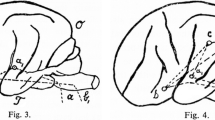Abstract
Although it is generally accepted that human superior temporal gyrus is activated by a huge variety of auditory and linguistic tasks, little is known about the exact positions and extents of cortical areas that are located on the lateral convexity of the gyrus (e.g., Brodmann’s area 22). Such information, however, is relevant for a rigorous testing of structural-functional relationships in both normal volunteers and patients suffering from disorders of auditory and language perception. The present combined cytoarchitectonic and receptorarchitectonic study identifies a distinct area (Te3) in the lateral bulge of the superior temporal gyrus by using an algorithm-based approach for the detection of cortical borders. Our mapping data show that, in contrast to Brodmann’s area (BA) 22, only small portions of Te3 reach the dorsal and ventral banks of the gyrus. Therefore, we labelled the newly defined area as “Te3” and not as “BA 22”. The cytoarchitectonically defined borders of Te3 coincide with abrupt changes in the receptorarchitecture of several classical neurotransmitters, suggesting that Te3 represents a functionally relevant area of the human superior temporal gyrus. Since position and extent of area Te3 varied considerably between subjects, probability maps were created that show for each voxel of the standard references space, the frequency with which Te3 was present in it. These maps, in combination with previously published maps of the primary auditory cortex, can directly be compared with functional imaging data, and may open new perspectives for the analysis of structural-functional correlations in the human auditory and language systems.





Similar content being viewed by others
References
Amunts K, Weiss PH, Mohlberg H, Pieperhoff P, Eickhoff S, Gurd JM, Marshall JC, Shah NJ, Fink GR, Zilles K (2004) Analysis of neural mechanisms underlying verbal fluency in cytoarchitectonically defined stereotaxic space—the roles of Brodmann areas 44 and 45. Neuroimage 22(1):42–56
Binder JR, Frost JA, Hammeke TA, Cox RW, Rao SM, Prieto T (1997) Human brain language areas identified by functional magnetic resonance imaging. J Neurosci 17:353–362
Brodmann K (1909) Vergleichende Lokalisationslehre der Grosshirnrinde in ihren Prinzipien dargestellt auf Grund des Zellenbaues. Barth, Leipzig
Collins DL, Neelin P, Peters TM, Evans AC (1994) Automatic 3D intersubject registration of MR volumetric data in standardized Talairach space. J Comput Assist Tomogr 18:192–205
Evans AC, Collins DL, Mills SR, Brown ED, Kelly RL, Peters TM (1993) 3-D statistical neuroanatomical models from 305 MRI volumes. IEEE-NSS-MI Symp pp 1813–1817
Friederici AD, Kotz SA (2003) The brain basis of syntactic processes: functional imaging and lesion studies. Neuroimage 20(Suppl 1):8–17
Galaburda A, Sanides F (1980) Cytoarchitectonic organization of the human auditory cortex. J Comp Neurol 190:597–610
Henn S, Schormann T, Engler K, Zilles K, Witsch K (1997) Elastische Anpassung in der digitalen Bildverarbeitung auf mehreren Auflösungsstufen mit Hilfe von Mehrgitterverfahren. In: Paulus E, Wahl FM (eds) Informatik aktuell. Springer, Berlin, pp 392–399
Henschen SE (1917) Über die Hörsphäre. J f Psychol u Neurol 22:319–479
Holmes CJ, Hoge R, Collins L, Woods R, Toga AW, Evans AC (1998) Enhancement of MR images using registration for signal averaging. J Comput Assist Tomogr 324–333
Hopf A (1954) Die Myeloarchitektonik des Isokortex temporalis beim Menschen. J Hirnforschung 1:208–279
Jancke L, Mirzazade S, Shah NJ (1999) Attention modulates activity in the primary and the secondary auditory cortex: a functional magnetic resonance imaging study in human subjects. Neurosci Lett 266:125–128
Mohlberg H, Weiss PH, Fink GR, Zilles K, Amunts K (2002) Integration of a new non-linear elastic warping method and SPM99: verbal fluency and cytoarchitecture. NeuroImage 16:492
Morosan P, Rademacher J, Schleicher A, Amunts K, Schormann T, Zilles K (2001) Human primary auditory cortex: cytoarchitectonic subdivisions and mapping into a spatial reference system. Neuroimage 13:684–701
Morosan P, Rademacher J, Palomero-Gallagher N, Zilles K (2005) Anatomical organization of the human auditory cortex: cytoarchitecture and transmitter receptors. In Heil P, König E, Budinger E (eds) Auditory cortex: towards a synthesis of human and animal research. Lawrence Erlbaum, Mahwah, New Jersey
Rivier F, Clarke S (1997) Cytochrome oxidase, acetylcholinesterase, and NADPH-diaphorase staining in human supratemporal and insular cortex: evidence for multiple auditory areas. Neuroimage 6:288–304
Schleicher A, Zilles K (1990) A quantitative approach to cytoarchitectonics: analysis of structural inhomogeneities in nervous tissue using an image analyser. J Microsc 157(Pt 3):367–381
Schleicher A, Amunts K, Geyer S, Morosan P, Zilles K (1999) Observer-independent method for microstructural parcellation of cerebral cortex: A quantitative approach to cytoarchitectonics. Neuroimage 9:165–177
Talairach J, Tournoux P (1988) Coplanar Stereotaxic Atlas of the Human Brain. Thieme, Stuttgart
von Economo C, Koskinas GN (1925) Die Cytoarchitektonik der Hirnrinde des erwachsenen Menschen. Springer, Berlin
Wallace MN, Johnston PW, Palmer AR (2002) Histochemical identification of cortical areas in the auditory region of the human brain. Exp Brain Res 143:499–508
Wernicke K (1874) Der aphasische Symptomencomplex Eine psychologische Studie auf anatomischer Basis. Hohn and Weigert, Breslau
Zilles K, Schleicher A, Palomero-Gallagher N, Amunts K (2002a) Quantitative analysis of cyto- and receptor architecture of the human brain. In: Mazziotta JC, Toga A (eds) Brain mapping: the methods. Elsevier, USA, pp 573–602
Zilles K, Palomero-Gallagher N, Grefkes C, Scheperjans F, Boy C, Amunts K, Schleicher A (2002b) Architectonics of the human cerebral cortex and transmitter receptor fingerprints: reconciling functional neuroanatomy and neurochemistry. Eur Neuropsychopharmacol 12:587–599
Acknowledgments
This Human Brain Project/Neuroinformatics research is funded by the National Institute of Biomedical Imaging and Bioengineering, the National Institute of Neurological Disorders and Stroke, and the National Institute of Mental Health. Additional funding of the receptor studies is provided by VWStiftung and DFG (Klinische Forschergruppe).
Author information
Authors and Affiliations
Corresponding author
Rights and permissions
About this article
Cite this article
Morosan, P., Schleicher, A., Amunts, K. et al. Multimodal architectonic mapping of human superior temporal gyrus. Anat Embryol 210, 401–406 (2005). https://doi.org/10.1007/s00429-005-0029-1
Published:
Issue Date:
DOI: https://doi.org/10.1007/s00429-005-0029-1




